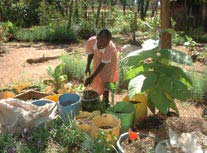Taking Care of a Tree Nursery
Each young tree could grow into a large one, but to have a good chance of doing so it needs help, especially at key stages in its development:
Avoiding climatic stresses
The most important ways of limiting its likelihood and severity are by: (a)
shading the young trees, particularly for species that are shade-tolerant and
all species during the key stages when special care is needed; (b) WateringFor wet areas or wet seasons:
Dig holes and canals to drain water; add compost to drain clay soil; grow plants that love water (e.g. rice, taro, lotus, water chestnuts); protect young plants from heavy rain; grow plants on trellises and use containers; don't mulch too much
For dry areas or dry seasons:
Use “grey water” from washing; harvest rainwater with gutters and water tanks; grow crops near the water; prevent runoff - put beds across slopes and build up edges; use water conservatively - use a drip system, NOT a sprinkler; use a lot of compost and mulch; provide shade for young plants; remove competitive weeds that steal water; grow dry-climate crops (e.g. mung bean, egg-plant, sweet-potato, mango, groundnut, okra).
Methods of watering plants
• Flood the bed - in dry places make a sunken bed to keep the water in.
• Drip irrigation - use a drip hose or soaker hose.
• Water by hand with a watering can or a plastic bottle with holes.
• Make water traps - e.g. keep the water in by digging a shallow trough round the plant.
• Water plants individually with sunken tins or upended bottles
Watering advice
• Water seeds and seedlings gently.
• Don’t drown plants by over-watering. If they need a lot of water, give it in stages.
• Water the soil, not the plants. Get the water to the roots. Water on leaves can hurt plants.
• Don’t use a sprinkler - it wastes water.
• Measure moisture each day with a measuring stick. When the top 3 cm is dry it’s time to water.
• Water in the morning or evening when it is cool so the water doesn’t evaporate.
• Deep roots don’t need more water: let plants dry out between waterings to encourage roots to grow.
young trees regularly and carefully, weedingYou must catch weeds before they seed and make sure you get the roots out or cut offthe weed below the surface of the soil. Some weed attract beneficial insects, others make a good contribution to the compost heap containers and beds, and using
mulchesMulching means putting dry organic material (grass, straw, leaves) about 6 cm deep around the base of plants. The mulch keeps moisture in the soil, keeps the soil surface cool and soft, prevents weeds, and gradually decays like compost to enrich the soil. It is particularly useful where the soil is poor or there is very little water, in hot climates and hot seasons. The best mulching material is light-coloured and reflects the light. Use grass and weeds before they produce seeds, otherwise you will be providing competition instead of reducing it! where appropriate; (c) Protecting the whole nursery area against
wind; (d) Preventing roots from getting long instead of well-branched; and
(e) Avoiding sudden exposure of young trees to more stressful conditions.
Watering
It is important to have a reliable source of water that is reasonably clean, without
having much salt, oil or toxic chemicals dissolved in it or fine soil particles
suspended in it. Every potted plant should be watered twice a day, the
seed trays, seed beds and transplant beds once a day. See modules rainwater
harvesting, greywater reuse, wind pumps, solar pumps.









